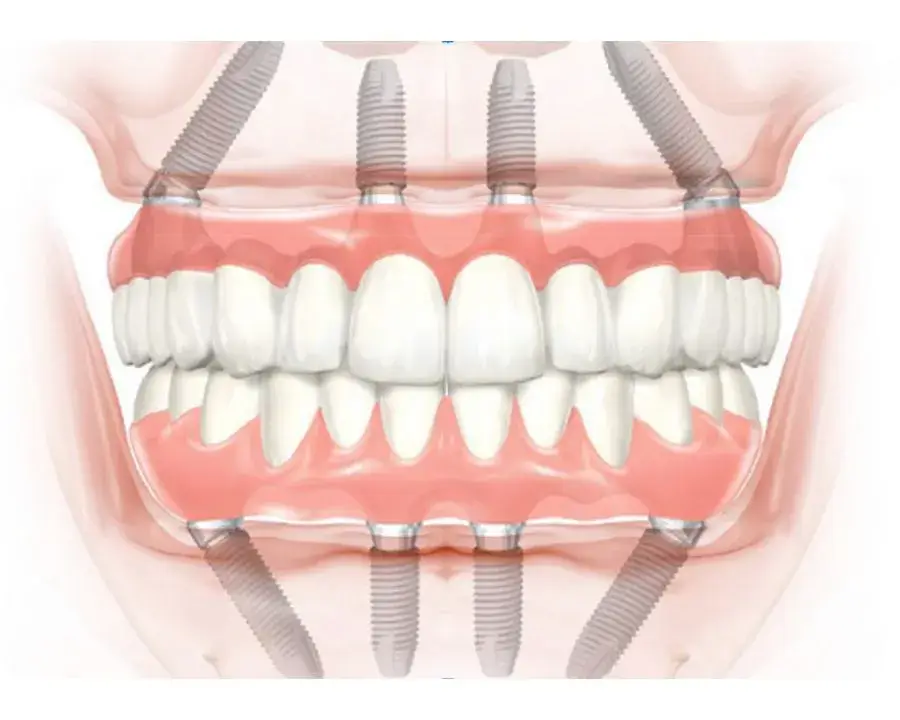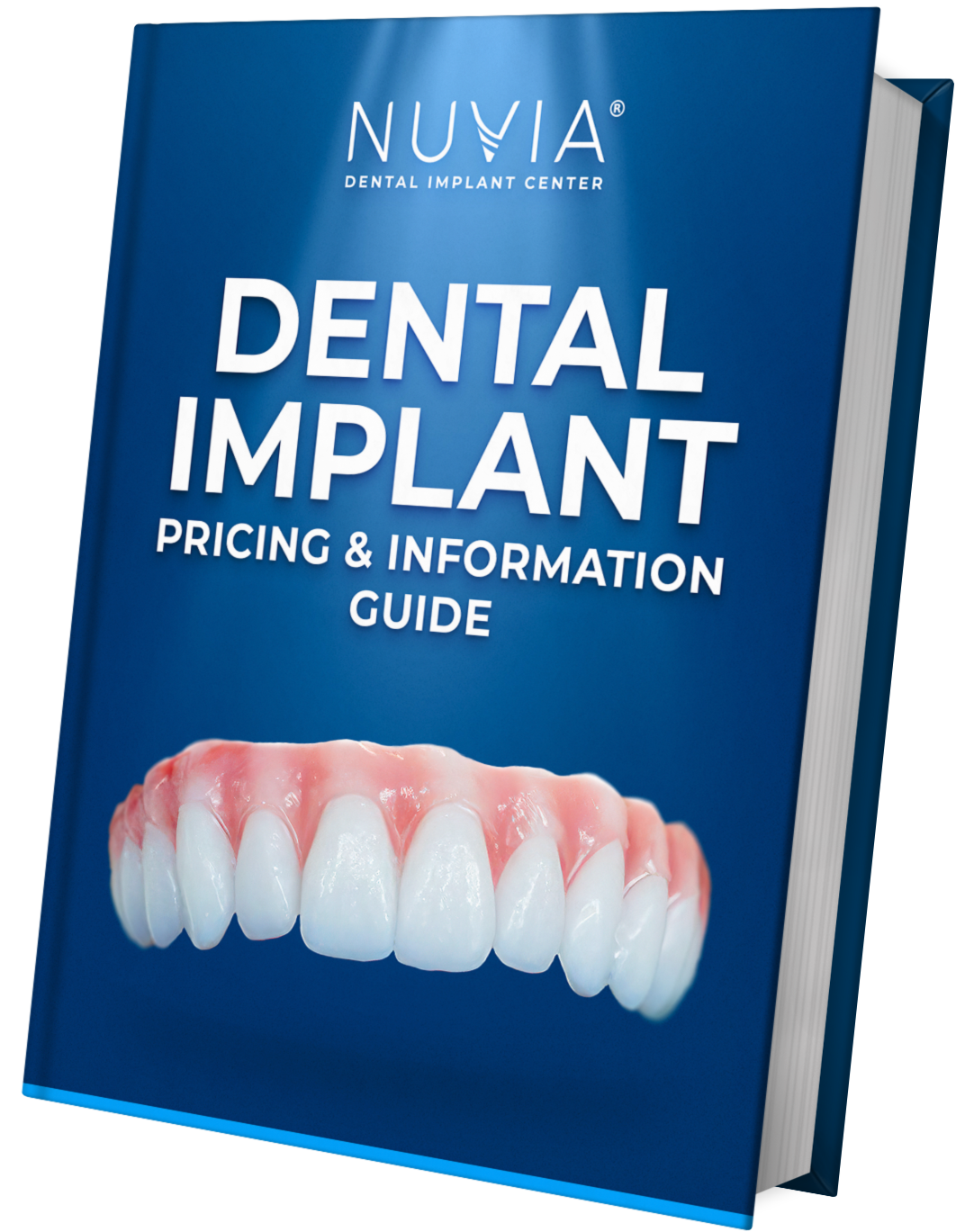
What Are All On 4 Dental Implants?

40 Years Later They Were Still In In His Mouth!
It’s thought that one of the very first types of All On 4® Dental Implant procedures was done by Dr. Branemark in the 1960s!
His first All On 4 Type Patient was named Gosta Larsson...
…A SUPER cool fact about him is that he died 40 years later with his dental implants STILL intact.
It’s not the highest quality photo but this is literally a picture of the two of them together. The patient is on the left (Larsson) and the doctor (Branemark) is on the right. We’ve also included a ct image of the patient's implants as well. Kinda cool right?

But of course, we cannot talk about the beginnings of All On 4® without recognizing Professor Paulo Malo, from Portugal, along with Nobel Biocare who were some of the first to put in the work to further develop the technique.
As a result of their work placing the implants on the upper jaw at a 45-degree angle became a commonplace procedure.
Why is that important?
Well, on the upper jaw the sinus cavities come down and meet our jawbone toward the back of our mouth. So initially it was very difficult for implants to be placed in the back of the upper jaw.
You can see in the image below that the implants in the back are tilted at an angle to miss the sinus cavity.

That’s great because they can still give you enough stability to support the teeth in the back of your mouth.
So What Exactly Is All On 4®?
It simply means that a new set of lab-made teeth are anchored to 4 implants in the jawbone.
As you’ll see in the short video below all the teeth on at least 1 arch are removed, four implants are put into the jawbone and then a new set of prosthetic teeth are attached.
(By the way “arch” basically just means a full upper or lower set of teeth and prosthetic teeth just means made in a lab).
How Long Do They Last?
The answer to this question will always be “it depends.”
Of course that’s not the answer you’re looking for so let’s get into a few specific details.
This Study shows great success with this type of procedure for subjects for up to 18 years!
That’s pretty cool.
But goal is to get them to last as long as possible and like you read above Larsson’s implants stayed in for 40 years.
So what are some of the factors that determine how long they last? Here are a few…
How well you maintain them.
A wonderful benefit of dental implants and prosthetic teeth is that they cannot get cavities but unfortunately they still aren’t set it and forget it.
They still require daily maintenance similar to normal teeth, mainly brushing and flossing. Most of the time the flossing can just be done with a water pik (water flosser). The water pik just shoots a small stream of water at the area you point it to and viola! Flossing complete!
Your overall health
There are certain health conditions that may make it more difficult for the jawbone to osseointegrate (or fuse) to the implant.
Uncontrolled diabetes is one of them. This study on diabetes and dental implants however shows that as long as the diabetes is controlled long terms results are still fantastic.
Osteoporosis. Many patients have questions about how osteoporosis may affect all on 4 dental implants. A different study shows that just like diabetes there is no significant relationship between osteoporosis and dental implant failure. However, depending on the progression of the disease it may produce different outcomes.
Smoking And Radiation
Smoking and Radiation in this study were found to have a direct correlation with causing implant failure. The study found that both smoking and radiation both impaired the wound healing process involved with implant and tissue healing.
The good news is that for most patients many studies suggest a 98% chance or greater that the implants integrate with the bone properly and that is very encouraging.
The Traditional Process of Getting All On 4® Dental Implants
Up until recently, the process of getting a permanent set of teeth with the All On 4 Method has taken up to 10 months or maybe even longer.
On the day of surgery, the dentist or surgeon extracts all the teeth on each arch. (an arch is just a full upper or lower set of teeth, the image below is a bottom arch for example.) Then 4 to 6 implants are placed in the jawbone.

After that, the provider takes a denture, drills holes into it, and temporarily fixes it to the implants giving you the appearance of teeth.
Next, the patient will remain in that temporary acrylic set for four to six months. Then after that four to six-month period, a process commonly referred to as wax try-ins begins. You can read more in detail about wax try-ins here.
Finally, after up to 10 months or longer a final set of teeth would be attached to the implants placed.
Nuvia’s Permanent Teeth In 24 Hours.
Nuvia Dental Implant Centers utilize many techniques similar to the All On 4 Method. We use four to six implants and angle them accordingly.
Where Nuvia processes differ from the traditional all-on-4 procedure commonly referred to as “teeth in a day” is that we never place patients in a temporary acrylic denture on the same day of surgery. Read more about the difference here.
It is our goal for each patient to receive a permanent set of teeth the very next day and skip the temporary acrylic process altogether.
Not all patients are qualified to receive a permanent set the next day depending on health conditions and diagnosis. No acrylic temporaries are used.
The possible benefits of this can be seen on our main website homepage at NuviaSmiles.com
Watch this awesome 24-hour smile transformation to see our 24-hour permanent teeth in action.
All On 4 Dental Implant Costs
When considering dental implants it is important to consider that regardless of the path we take to fix our teeth, we have to pay for the dental work over time.
We’ve had several patients tell us that they believe they would have paid just as much to repair their teeth (if not more) for the rest of their lives than they did to get their teeth fixed. The blessing with dental implants is you don’t have to keep worrying about your teeth deteriorating.
As we explain in our ultimate guide to full-mouth dental implants, around 92% of our patients get their funding up front with an affordable monthly payment plan.
Monthly payments for a single arch might average around $250/mo to $450/mo and the full fees might range from $24,000 to $28,000 an arch.
Remember to always do your own research and understand what you’re getting. This procedure is not something you want to have to re-do so. If someone is charging WAY less than that average they might just be trying to get business.
Buyer beware!
There are no board certifications for dental implant work. A dentist can take a weekend course and start doing full-mouth dental implant procedures.
Full mouth dental implants done by Oral Surgeons who provide a permanent set in 24 hours is the ONLY procedure we do at Nuvia. Day In Day out… that should bring comfort as you’re deciding who to go with.
Factors That Influence The Cost Of All On 4®
There are several factors that might influence the cost of all on four.
- Location Of The Practice - Downtown metropolitan offices may have to charge more because it costs them more to run their practice with more expensive real estate.
- In-House Labs Vs Outside Labs - At Nuvia we have our own in-house labs. Outside labs have to make a profit so the provider may end up passing those additional costs on to you.
- Complexity Of Your Case - If by chance you need a more unique solution because of bone loss or other factors, the procedure may end up costing more.
- Experience Of The Provider - In some cases, those who are new to this procedure may reduce costs in order to get experience and patients...
How To Know If This Is The Right Procedure For You
If you’ve been thinking something like, “maybe I should just remove them all and start over,” thats a good place to start. As mentioned above this procedure requires all teeth in the chosen arch to be extracted.
If that’s true your next step is to get a CT scan in one of our locations. The procedure requires enough healthy bone to accept the implants. The only way to know if you’re bone has the right capacity for dental implants is to get one of these scans. After that, you’ll know how much the procedure will cost for you and what your payment might be.
CLICK HERE to take our eligibility quiz.
More Articles Like This one

The Truth About Bone Loss and Dentures Revealed.

Do Dentures Still Work For People With A Small Mouth? Find Out!






